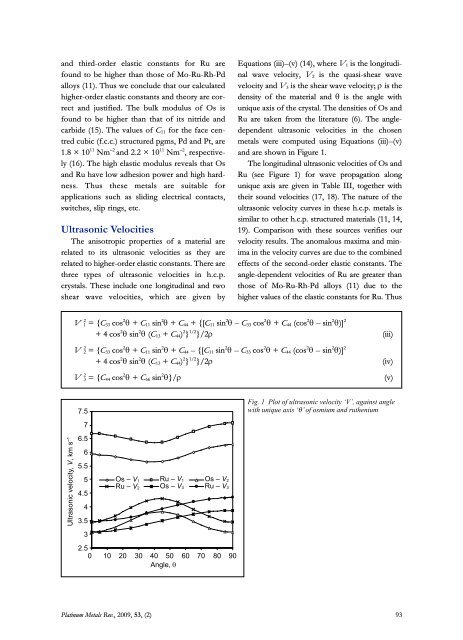Ultrasonic Study of Osmium and Ruthenium - Platinum Metals Review
Ultrasonic Study of Osmium and Ruthenium - Platinum Metals Review
Ultrasonic Study of Osmium and Ruthenium - Platinum Metals Review
You also want an ePaper? Increase the reach of your titles
YUMPU automatically turns print PDFs into web optimized ePapers that Google loves.
<strong>and</strong> third-order elastic constants for Ru are<br />
found to be higher than those <strong>of</strong> Mo-Ru-Rh-Pd<br />
alloys (11). Thus we conclude that our calculated<br />
higher-order elastic constants <strong>and</strong> theory are correct<br />
<strong>and</strong> justified. The bulk modulus <strong>of</strong> Os is<br />
found to be higher than that <strong>of</strong> its nitride <strong>and</strong><br />
carbide (15). The values <strong>of</strong> C 11 for the face centred<br />
cubic (f.c.c.) structured pgms, Pd <strong>and</strong> Pt, are<br />
1.8 × 10 11 Nm –2 <strong>and</strong> 2.2 × 10 11 Nm –2 , respectively<br />
(16). The high elastic modulus reveals that Os<br />
<strong>and</strong> Ru have low adhesion power <strong>and</strong> high hardness.<br />
Thus these metals are suitable for<br />
applications such as sliding electrical contacts,<br />
switches, slip rings, etc.<br />
<strong>Ultrasonic</strong> Velocities<br />
The anisotropic properties <strong>of</strong> a material are<br />
related to its ultrasonic velocities as they are<br />
related to higher-order elastic constants. There are<br />
three types <strong>of</strong> ultrasonic velocities in h.c.p.<br />
crystals. These include one longitudinal <strong>and</strong> two<br />
shear wave velocities, which are given by<br />
Equations (iii)–(v) (14), where V 1 is the longitudinal<br />
wave velocity, V 2 is the quasi-shear wave<br />
velocity <strong>and</strong> V 3 is the shear wave velocity; ρ is the<br />
density <strong>of</strong> the material <strong>and</strong> θ is the angle with<br />
unique axis <strong>of</strong> the crystal. The densities <strong>of</strong> Os <strong>and</strong><br />
Ru are taken from the literature (6). The angledependent<br />
ultrasonic velocities in the chosen<br />
metals were computed using Equations (iii)–(v)<br />
<strong>and</strong> are shown in Figure 1.<br />
The longitudinal ultrasonic velocities <strong>of</strong> Os <strong>and</strong><br />
Ru (see Figure 1) for wave propagation along<br />
unique axis are given in Table III, together with<br />
their sound velocities (17, 18). The nature <strong>of</strong> the<br />
ultrasonic velocity curves in these h.c.p. metals is<br />
similar to other h.c.p. structured materials (11, 14,<br />
19). Comparison with these sources verifies our<br />
velocity results. The anomalous maxima <strong>and</strong> minima<br />
in the velocity curves are due to the combined<br />
effects <strong>of</strong> the second-order elastic constants. The<br />
angle-dependent velocities <strong>of</strong> Ru are greater than<br />
those <strong>of</strong> Mo-Ru-Rh-Pd alloys (11) due to the<br />
higher values <strong>of</strong> the elastic constants for Ru. Thus<br />
V 12 = {C 33 cos 2 θ + C 11 sin 2 θ + C 44 + {[C 11 sin 2 θ – C 33 cos 2 θ + C 44 (cos 2 θ – sin 2 θ)] 2<br />
+ 4 cos 2 θ sin 2 θ (C 13 + C 44) 2 } 1/2 }/2ρ (iii)<br />
V 22 = {C 33 cos 2 θ + C 11 sin 2 θ + C 44 – {[C 11 sin 2 θ – C 33 cos 2 θ + C 44 (cos 2 θ – sin 2 θ)] 2<br />
+ 4 cos 2 θ sin 2 θ (C 13 + C 44) 2 } 1/2 }/2ρ (iv)<br />
V 32 = {C 44 cos 2 θ + C 66 sin 2 θ}/ρ<br />
(v)<br />
<strong>Ultrasonic</strong> V (10 velocity, 3 ms -1 ) V, km s –1<br />
7.5<br />
7<br />
6.5<br />
6<br />
5.5<br />
5<br />
4.5<br />
4<br />
3.5<br />
Os-V1 – V 1<br />
Ru-V– 1V 1<br />
Os-V2 – V 2<br />
Ru-V– 2V 2 Os-V3 – V 3 Ru-V3 – V 3<br />
3<br />
2.5<br />
0 10 20 30 40 50 60 70 80 90<br />
Angle, θ<br />
Fig. 1 Plot <strong>of</strong> ultrasonic velocity ‘V’, against angle<br />
with unique axis ‘θ’ <strong>of</strong> osmium <strong>and</strong> ruthenium<br />
<strong>Platinum</strong> <strong>Metals</strong> Rev., 2009, 53, (2) 93
















